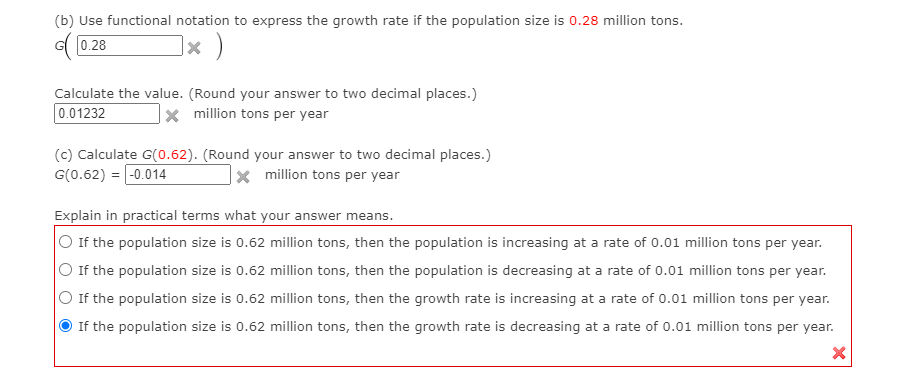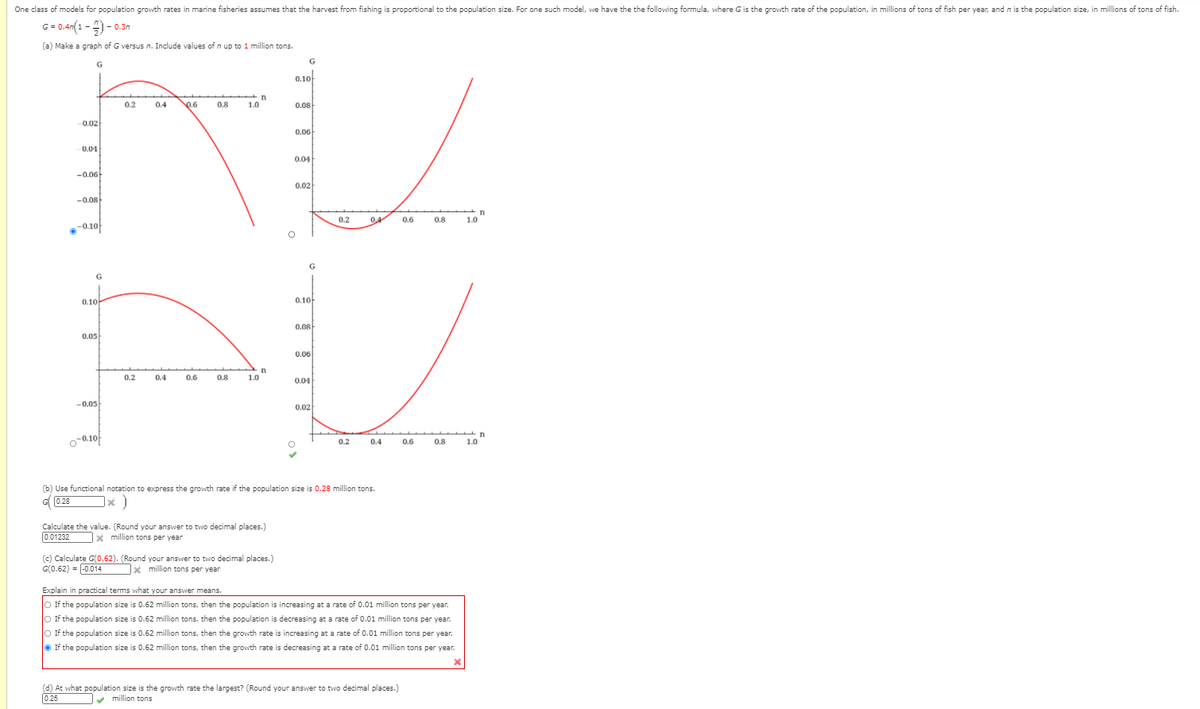e class of models for population growth rates in marine fisheries assumes that the harvest from fishing is proportional to the population size. For one such model, we have the the following formulla, where Gis the growth rate of the population, in millions of tons of fish per year, and n is the population size, in milions of tons of fish. 0.3 (a) Make a graph of G versus n. Include values of n up to i million tons. G 0.10 02 04 10" 0.08 0.02 0.06 0.01 0.04 -0.06 0.02 -0.08 0.2 0.6 08 1.0 -0.1아 0.10 - 0.10- 0.0s 0.00 2 0.8 0.2 04 0.6 10 0.01 -0.05 0.02 o-0.10 0.2 0.4 0.6 10 (b) Use functional notation to epress the growth rate if the population size is 0.28 million tons. d028 x ) Calculate the value. (Round your answer to two decimal places-) 001232 xx million tons per year (c) Calculate G0.62). (Round your ansver to two decimal places.) G(0.62) = 0014 x million tons per year Explain in practical terms what your answer means. If the population size is 0.62 million tons, then the population is increasing at a rate of 0.01 million tons per year. O F the population size is 0.62 million tons. then the population is decreasing at a race of 0.01 million tons per year O F the population size is 0.62 million tons, then the growth rate is increasing at a rate of 0.01 million tons per year. e F the population size is 0.62 million tons, then the growth rate is decreasing at a rate of 0.01 million tons per year. C) At what population size is the grovth rate the largest? (Round your answer to two decimal places.) 025 v million tons
Family of Curves
A family of curves is a group of curves that are each described by a parametrization in which one or more variables are parameters. In general, the parameters have more complexity on the assembly of the curve than an ordinary linear transformation. These families appear commonly in the solution of differential equations. When a constant of integration is added, it is normally modified algebraically until it no longer replicates a plain linear transformation. The order of a differential equation depends on how many uncertain variables appear in the corresponding curve. The order of the differential equation acquired is two if two unknown variables exist in an equation belonging to this family.
XZ Plane
In order to understand XZ plane, it's helpful to understand two-dimensional and three-dimensional spaces. To plot a point on a plane, two numbers are needed, and these two numbers in the plane can be represented as an ordered pair (a,b) where a and b are real numbers and a is the horizontal coordinate and b is the vertical coordinate. This type of plane is called two-dimensional and it contains two perpendicular axes, the horizontal axis, and the vertical axis.
Euclidean Geometry
Geometry is the branch of mathematics that deals with flat surfaces like lines, angles, points, two-dimensional figures, etc. In Euclidean geometry, one studies the geometrical shapes that rely on different theorems and axioms. This (pure mathematics) geometry was introduced by the Greek mathematician Euclid, and that is why it is called Euclidean geometry. Euclid explained this in his book named 'elements'. Euclid's method in Euclidean geometry involves handling a small group of innately captivate axioms and incorporating many of these other propositions. The elements written by Euclid are the fundamentals for the study of geometry from a modern mathematical perspective. Elements comprise Euclidean theories, postulates, axioms, construction, and mathematical proofs of propositions.
Lines and Angles
In a two-dimensional plane, a line is simply a figure that joins two points. Usually, lines are used for presenting objects that are straight in shape and have minimal depth or width.
Please answer parts (b) and (c).


Trending now
This is a popular solution!
Step by step
Solved in 2 steps with 2 images









